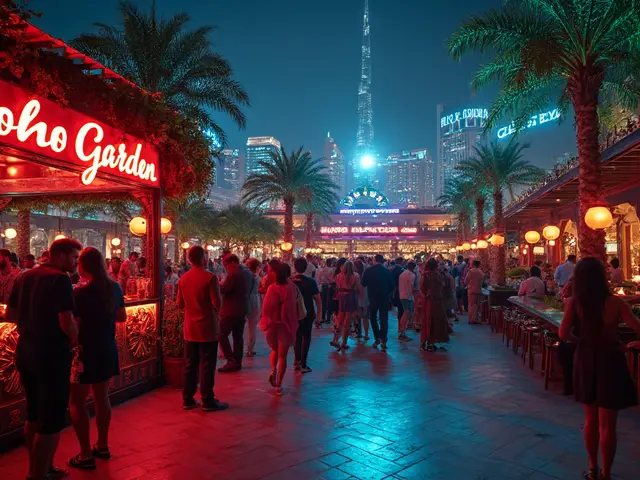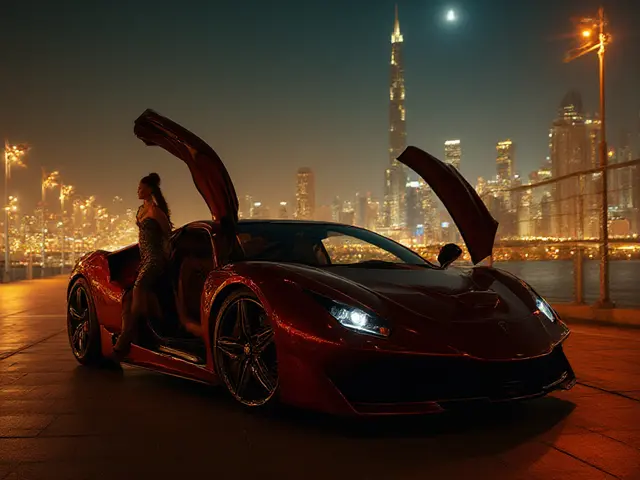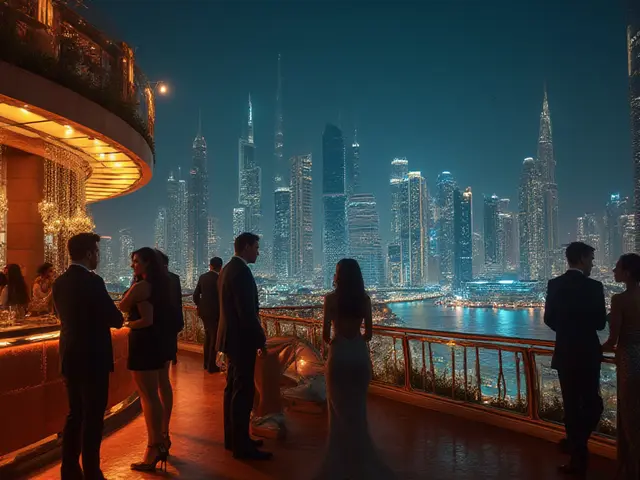![]()
Dubai isn’t just another city—it’s where imagination meets reality in the form of jaw-dropping buildings. If you’ve ever driven down Sheikh Zayed Road or simply stood outside The Dubai Mall, you’ve seen a skyline that tells a much bigger story. Each building is more than just concrete or glass; it’s a mix of big dreams, wild engineering, and local flair.
But knowing what makes these landmarks so special? That changes everything. For anyone living, working, or traveling in Dubai, these buildings aren’t just places to visit—they’re pieces of the city’s identity. Whether you’re snapping selfies at the Burj Khalifa, booking a sunset tea at Burj Al Arab, or checking out the Museum of the Future during RTA’s free museum days, knowing the backstories helps you see Dubai with fresh eyes.
Skip the typical tour guide speech. Instead, let’s break down what makes these places tick—why the Burj Khalifa glitters with a million LED lights, what inspired the sail shape of Burj Al Arab, where to find the best shot of the Dubai Frame, and how Al Fahidi Historic District quietly keeps old Dubai alive. Ready to get a little deeper? Let’s get into the stories hiding behind those stunning facades.
- Burj Khalifa: More Than the World’s Tallest
- Burj Al Arab: How Luxury Meets Tradition
- Museum of the Future: Dubai’s Vision in Steel and Glass
- Jumeirah Mosque: Bridging Cultures in Stone
- Atlantis The Palm: An Island Fantasy Realized
- From Al Fahidi to Dubai Frame: Past Meets Present
Burj Khalifa: More Than the World’s Tallest
Bursting out of Downtown Dubai, the Burj Khalifa isn’t just famous because it’s tall—though let’s be honest, it’s crazy tall. At 828 meters and 163 floors, it’s officially the world’s tallest building, but there’s a whole lot more going on behind those shiny windows.
People who live in Dubai know that the Burj Khalifa is more than just a record-breaker. It’s the heart of city celebrations—from New Year’s Eve fireworks lighting up every floor, to Ramadan light shows put on by Emaar that you can see from Business Bay to Deira. The tower is even visible from Sharjah on a clear day.
If you’re thinking of visiting, don’t just go for the ‘At The Top’ observation deck at level 124. There’s an even higher, less crowded spot at level 148 called ‘At The Top SKY’, and yes, you can book VIP tickets. For residents, grabbing a coffee at The Café on Level 148 is a low-key flex, while tourists should definitely hit up the outside deck for sunset views towards the Gulf.
What surprises a lot of folks is how sustainable the building is. There are systems to recycle condensation from the AC, which are then used to water the landscaping around the Dubai Fountains. That’s 15 million gallons of water saved every year—nothing wasted, even with all that glass.
| Burj Khalifa Quick Facts | Details |
|---|---|
| Total Height | 828 meters |
| Floors | 163 + 2 basement levels |
| Observation Decks | Level 124, Level 148 |
| Elevators | 57 total, fastest: 10m/sec |
| Glass Panels | 26,000 |
| Year Opened | 2010 |
Downstairs, there’s direct access to Dubai Mall—handy if you want to mix luxury shopping with your skyline adventure. Tip for families: during peak times (especially Eid and school holidays), book tickets online and arrive early. The lines can get long, but having a midday slot is usually less busy.
For Instagram shots, the best spots are the Burj Park promontory, the Palace Hotel walkway, or right by the Dubai Fountain Boardwalk. Locals know the early morning (right after sunrise) is your best bet for nearly empty backgrounds and soft light on the glass. And for the record, every New Year’s, the Burj Khalifa’s LED panel display is seen by millions on livestream—so it’s not just Dubai watching. This tower doesn’t just define the skyline; it helps define what Dubai is all about: huge goals, new ideas, and doing things bigger and bolder than anywhere else.
So the next time you see the Dubai iconic buildings hashtag, you’ll know Burj Khalifa isn’t just tall—it’s a whole experience, packed with tech, culture, and epic city views.
Burj Al Arab: How Luxury Meets Tradition
The Burj Al Arab isn’t just a hotel—it’s a whole brand. If you live in Dubai, you’ve probably seen it even if you've never gone inside. People call it the world’s only “seven-star” hotel, even though that rating doesn’t officially exist. The sail-shaped building rises 321 meters above the Gulf, and it’s packed with little nods to Emirati style right alongside pure international glitz.
The hotel opened in December 1999 after more than five years of work. Inside, you’ll find 202 duplex suites, each with massive floor space. The Royal Suite, for example, covers over 780 square meters. If you ever wondered why people book it for weddings or big birthdays, now you know.
But the Burj Al Arab is more than size and flash. Its design was inspired by the sail of a dhow, which you’ll spot bobbing along Dubai Creek. Inside, you’ll see mosaics, Arabic calligraphy, and even a golden elevator. The tiniest detail often has a local twist. For example, the wave-patterned carpets take cues from Arabian Gulf waters, while the palm-shaped landscaping outside nods to regional greenery.
"The Burj Al Arab typifies Dubai’s knack for mixing showstopping luxury with heritage—it’s a 21st-century landmark built on centuries-old traditions." — Architectural Digest Middle East
You don’t just have to stay the night to get the full experience. Afternoon tea at the Skyview Bar comes with unbeatable city views (pro tip: book well in advance, especially around Eid). Or try dinner at Al Mahara, where the floor-to-ceiling aquarium lets you dine surrounded by fish, without ever visiting Atlantis.
Want to know what makes this hotel extra? Here’s a table with a few wild numbers:
| Fact | Details |
|---|---|
| Height | 321 meters |
| Gold Leaf Used | Over 1,790 sqm |
| Number of Suites | 202 |
| Average Nightly Rate (AED) | AED 6,000 – 25,000+ |
| Helipad Events | Roger Federer & Andre Agassi, Tiger Woods, Red Bull F1 |
Here are some tips if you want to experience the Dubai iconic building up close without actually staying:
- Book a meal at one of the restaurants—many people do this just to get inside and snap photos.
- Consider the guided Inside Burj Al Arab tour (tickets online) for behind-the-scenes stories and photo ops you won’t get elsewhere.
- If you drive, valet parking is included with reservation confirmation, but taxis and Careem rides are also welcome at the forecourt.
Burj Al Arab sits just off Jumeirah Beach Road on an artificial island—a location that let the designers go wild without hitting restrictions. Its silhouette has become shorthand for Dubai’s taste for the bold, but every gleam and curve is anchored in real tradition. That’s where the magic happens.
Museum of the Future: Dubai’s Vision in Steel and Glass
If you drive down Sheikh Zayed Road, you can’t miss this place—it’s the silver, oval-shaped building with Arabic calligraphy glowing at night. Opened in 2022, the Museum of the Future already feels like a classic landmark for anyone curious about Dubai iconic buildings. Unlike most museums that look back, this one is all about what’s next for the world—and for Dubai.
The architecture is wild. Designed by Shaun Killa, the museum’s doughnut shape represents “the unknown of the future.” The calligraphy isn’t just decoration—it’s actual poetry by Sheikh Mohammed bin Rashid Al Maktoum, Dubai’s ruler. The building stands on three floors above ground, with a big open space in the middle, hinting at unlimited possibility.
Step inside and you’ll find itself living up to the hype. There’s no dusty artifact here. Instead, you’ll see what medicine, travel, and city life could look like in 2071 (the UAE’s 100th birthday). It’s split into themed areas, so if you’re bringing the family, check out the “Future Heroes” zone just for kids. They get to solve problems and invent things. For adults, the lab spaces and interactive exhibits have tech that hasn’t even hit Dubai’s stores yet.
If you want to plan a visit, book in advance on the official website. Walk-ins usually get turned away, especially on weekends and during school breaks. Tickets as of May 2025 are AED 149 for adults, with free entry for kids under 4, and there’s a dedicated parking zone under the Emirates Towers bridge. Pro tip: aim for an evening slot when the façade lights up—it makes for unbeatable Instagram shots.
| Fact | Details |
|---|---|
| Height | 77 meters |
| Construction Time | Approx. 6 years |
| Calligraphy | Quotes from Sheikh Mohammed |
| Opened | February 2022 |
| Lead Architect | Shaun Killa |
Sustainability is a big deal here, too. The building uses smart glass, solar power panels, and advanced water recycling. Even the landscaping around it uses native plants and efficient irrigation, which is rare in Dubai’s desert climate.
For locals, it’s also a cool events spot. The government sometimes hosts innovation talks and tech launches here, especially during Dubai Future Week or Expo spin-offs. If you want to experience Dubai’s forward-thinking attitude, this museum isn’t just a must-see—it’s a glimpse into the city’s ambitions, right down to the steel and glass.
Jumeirah Mosque: Bridging Cultures in Stone
The Dubai iconic buildings list wouldn’t be complete without the Jumeirah Mosque. Sitting right on Jumeirah Beach Road, it’s one of the most photographed mosques in the UAE. Built entirely out of white stone in traditional Fatimid style, its twin minarets and central dome are an easy spot from the road. Construction wrapped up in 1979, but the mosque looks much older, thanks to its classic design.
What really sets Jumeirah Mosque apart is its openness. It’s one of the rare mosques in Dubai that welcomes non-Muslims for guided tours. The Sheikh Mohammed Centre for Cultural Understanding (SMCCU) has run tours here for years, offering a real chance for residents and tourists to learn about Emirati culture and Islamic traditions—no filter, no hard sell.
The tour lasts about 75 minutes, and starts at 10am most days, except Friday. You don’t even have to book in advance—just show up a little early. Dress modestly (shoulders, arms and legs covered for both men and women), and ladies will be given a scarf to use if needed.
"We believe the mosque is the best place to ask, learn, and understand, which is why we say 'Open Doors. Open Minds.'" — Sheikh Mohammed Centre for Cultural Understanding
Here’s what you actually get during the visit: an easy-to-understand intro to prayer, a Q&A where no question is off-limits, and a guided walk around the prayer hall. Many people are surprised at how open the SMCCU hosts are—they’re used to every question, from food to fasting to architecture.
You’ll also see fascinating details, like the intricate Arabic calligraphy on the walls, the giant chandelier, and examples of geometric pattern work unique to Islamic design. Jumeirah Mosque can hold up to 1,200 worshippers during Friday prayers, and feels alive with community energy during Eid.
Here’s a quick look at some useful tips and practical details:
- How much does the tour cost? AED 35 per person, free for kids under 12.
- Photography? It’s allowed—just be respectful, especially during prayers.
- How to get there? Taxi and Careem are easiest. There’s also parking on site, but it fills up fast.
- What to wear? Modest clothing. SMCCU offers traditional attire to borrow if you forget.
- Best time to visit? Arrive by 9:45am for the morning tour and cooler temperatures.
If you like street food, grab a karak chai or paratha from a café across the street—it’s a kind of local tradition after a mosque tour.
| Founded | 1979 |
|---|---|
| Location | Jumeirah Beach Road, Dubai |
| Capacity | 1,200 worshippers |
| Tour Days | Saturday to Thursday (10am) |
| Tour Fee | AED 35 (free for under 12) |
For anyone trying to get beyond the skyscrapers and actually experience a slice of real Dubai life, Jumeirah Mosque is your best bet. You walk in a curious outsider, and walk out actually understanding more about the city than you thought possible.
Atlantis The Palm: An Island Fantasy Realized
If you’ve ever wondered whether Dubai really does things differently, just look at Atlantis The Palm. Built in 2008 at the edge of Palm Jumeirah—the world’s largest man-made island—this iconic resort became a Dubai landmark almost overnight. It’s not just a flashy hotel; it’s a symbol of how the city transforms wild ideas into reality.
Atlantis The Palm has over 1,500 rooms, 23 restaurants, and Aquaventure Waterpark, which is the largest waterpark in the Middle East. Families, thrill-seekers, and foodies all find something unforgettable here. The Lost Chambers Aquarium, with 65,000 marine animals, gives a kid-friendly peek into underwater life, while adults can try fine dining experiences like Nobu and Ossiano.
"Atlantis is more than a hotel; it’s a destination in itself. People come for the rooms, but stay for the experiences." — Ahmed Khalaf, General Manager, Atlantis The Palm
This resort stands out for more than just size. During its first month, Atlantis hosted a $20 million launch party, rumoured to be the most expensive hotel opening ever. The fireworks could be seen for miles across Dubai Marina. In 2024, over 1.2 million visitors stayed at the hotel, and guest bookings hit record highs during public holidays like Eid and New Year’s Eve.
For residents in Dubai, Atlantis is a go-to spot for staycations and weekend family trips. With special UAE resident rates and annual passes to Aquaventure, locals get more for less. You can even make a day of it with brunch options at Saffron (which has over 220 dishes) or walk down The Avenues for some retail therapy. If you’ve got family visiting, this is where you bring them to hit both the water rides and the underwater suites—that’s right, people actually sleep surrounded by real fish and rays.
If you love numbers and facts, here’s a quick at-a-glance table that stacks up:
| Fact | Detail |
|---|---|
| Opening Year | 2008 |
| Rooms & Suites | 1,548 |
| Restaurants | 23 |
| Main Attraction | Aquaventure Waterpark |
| Annual Visitors (2024) | 1.2 million+ |
| Fish in Aquarium | 65,000 |
This place isn’t just for tourists. If you’re living in Dubai, keep an eye on Atlantis’ official channels for flash deals or ticket combos. And if your Instagram needs a boost, those famous pink arches are always a crowd-pleaser. Atlantis really is a living example of what makes Dubai iconic buildings so different from anywhere else in the world.
From Al Fahidi to Dubai Frame: Past Meets Present
If you want to get Dubai, you have to see how the city handles its history and crazy-fast growth, all in one visit. This is where exploring Al Fahidi Historical Neighbourhood and Dubai Frame comes in—it’s literally a trip from the city’s roots to the wild future vibe everyone talks about.
First, Al Fahidi, sometimes called Al Bastakiya, sits right by Dubai Creek. Here, you get narrow lanes, wind towers built for natural cooling before air conditioning was a thing, and houses made of coral and mud. Walking around, you see what Dubai looked like before skyscrapers and shopping malls took over. This area hosts the Sheikh Mohammed Centre for Cultural Understanding (SMCCU), which is especially helpful for expats and tourists who want to learn about UAE customs—like why majlis seating matters or what Emirati breakfast actually tastes like. If you’re big on art, many of the old homes now house cool cafés, galleries, or even the annual Sikka Art Fair.
Then there’s the Dubai Frame, literally designed as a massive picture frame. Opened in January 2018 in Zabeel Park, it stands 150 meters tall and 93 meters wide. You can’t miss it. Here’s the fun part: From one side, the Sky Deck gives you a view of old Dubai (think: Deira, the Creek, and all that history), and from the other side, you see New Dubai—skyscrapers, Sheikh Zayed Road, all the way to the Burj Khalifa. The floor even has a section of smart glass, so if you’re feeling brave, step on it for a look straight down.
Want something practical?
- Al Fahidi is best seen in the morning before the heat kicks in—early risers get empty lanes and peaceful vibes.
- The Dubai Frame’s sunset slot books fast. Try weekdays for smaller crowds.
- If you’re using public transport, hop onto the Al Fahidi Metro station for the neighbourhood, or Al Jafiliya for the Frame—and a quick RTA bus can take you right to Zabeel Park’s gate.
- Grab a museum pass if you want entry to both Etihad Museum and Dubai Frame for a better deal (Emirates NBD and ADCB card offers pop up every few months).
Here’s a quick look at why these places matter—old and new:
| Landmark | Opened/Founded | Key Features | What Makes It Unique? |
|---|---|---|---|
| Al Fahidi Historical Neighbourhood | 1800s | Wind towers, art galleries, cultural cafés | Preserved slice of pre-oil Dubai, traditional Emirati culture |
| Dubai Frame | 2018 | 150m height, glass walkway, panoramic views | Frames the old and new city in one view; record-breaking architecture |
The real trick? Pair your visit. Grab a traditional karak tea in Al Fahidi, then jump in a taxi or hop on the Metro for a totally different view at the Frame. Dubai does contrasts better than anywhere: old Emirati courtyards suddenly switch to the world’s flashiest selfie spot. That’s not just sightseeing, that’s seeing Dubai’s actual story unfold.




